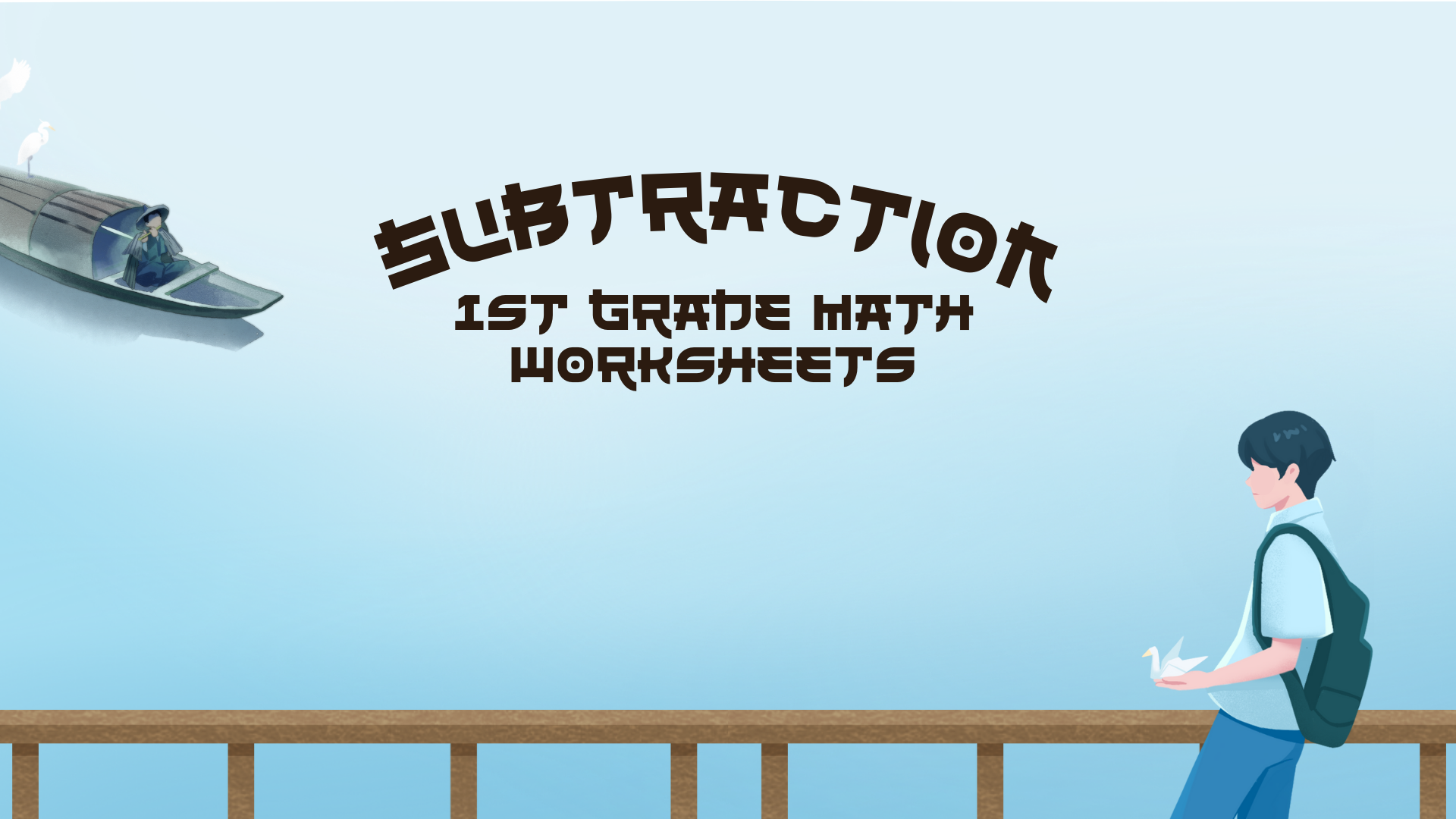
Table of Contents
Introduction to Grade 1 Subtraction Worksheets
Our grade 1 subtraction worksheets offer a comprehensive practice platform for young learners to master the fundamentals of subtraction. These exercises start with simple subtraction facts using visual aids such as pictures or number lines and gradually progress to more advanced problems, including the subtraction of 2-digit numbers arranged in columns. Notably, these worksheets are designed without the need for regrouping (often referred to as “borrowing”).
Introduction to Subtraction
Subtraction is one of the basic arithmetic operations that students begin to learn in grade 1. Here are some of the methods used to introduce and practice subtraction:
- Subtract by Crossing Out Objects:
- Students are provided with pictures where they practice subtraction by physically crossing out objects. This visual method helps them understand the concept of “taking away.”
- Subtract by Drawing & Crossing Out:
- Learners draw their own objects and then subtract by crossing them out. This method reinforces their understanding of subtraction through active participation.
- Solve Subtraction Word Problems with Objects:
- By solving word problems that involve objects, students apply subtraction in real-life scenarios. This approach not only tests their arithmetic skills but also their ability to comprehend and solve problems.
- Subtract Using Objects Example:
- An example is provided to guide students on how to subtract using objects, ensuring they grasp the concept before moving on to more complex problems.
Subtraction Sentences and Number Lines
- Select the Subtraction Sentence:
- This exercise requires students to choose the correct subtraction sentence that matches a given scenario or picture, helping them link visual cues to mathematical expressions.
- Write Subtraction Sentences:
- Students are encouraged to write their own subtraction sentences based on different visual or word-based prompts, fostering creativity and understanding.
- Subtraction Sentences Example:
- Examples are provided to demonstrate how to formulate and solve subtraction sentences, serving as a helpful reference.
- Subtract Using Number Lines:
- Number lines are a powerful tool in teaching subtraction. Students learn to subtract by moving backwards on a number line, which visually represents the subtraction process.
- Subtraction Sentences and Number Lines:
- Combining subtraction sentences with number lines helps students to visualize the subtraction process and strengthens their understanding.
- Subtract Using Number Lines Example:
- A step-by-step example of subtraction using a number line is included to guide students through this method.
Mental Subtraction Techniques
Mental math is a crucial skill, and these worksheets offer various exercises to sharpen it:
- Subtract Within 0-10:
- Simple subtraction problems such as “9 – 4” are provided for quick mental calculation.
- Subtract by Counting Back:
- Students practice subtracting by counting backwards, e.g., “9 – 4 =”. This method reinforces number sequencing and basic subtraction.
- Subtract by Counting Up:
- An alternative method where students count upwards from the smaller number to find the difference, e.g., “9 – 4 =”. This approach helps in understanding the relationship between addition and subtraction.
- Missing Minuend or Subtrahend (Within 10):
- Exercises like “8 – __ = 2” challenge students to determine the missing number in subtraction problems, enhancing their problem-solving skills.
- Subtract Within 1-20:
- Slightly more complex problems such as “17 – 3 =” are provided to extend the range of mental subtraction practice.
- Subtract 1-Digit from 1-100 (No Regrouping):
- Students work on problems like “67 – 6 =” that involve subtracting a single digit from a number up to 100 without regrouping.
- Subtract 1-Digit from 1-100 (Missing Numbers):
- Similar to the previous exercise but with a missing number, e.g., “67 – __ = 61”. This task further develops critical thinking and arithmetic skills.
Subtracting Whole Tens
Understanding tens is vital in subtraction, and these worksheets address this:
- Subtract Whole Tens:
- Problems such as “70 – 40 =” focus on subtracting multiples of ten, which is a key concept in early math education.
- Subtract Whole Tens (Missing Numbers):
- Similar to the previous task but with a missing number, e.g., “70 – __ = 30”. This exercise helps reinforce the concept of tens in subtraction.
- Subtract from Whole Tens:
- Problems like “20 – 3 =” involve subtracting a smaller number from a whole ten, furthering students’ understanding of place value and subtraction.
Subtracting in Columns
These exercises help students learn to subtract larger numbers systematically:
- Subtract 1-Digit from a 2-Digit Number (No Borrowing):
- Students subtract single digits from two-digit numbers without the need for regrouping, e.g., “67 – 3”.
- Subtract 2-Digit Numbers (No Borrowing):
- More advanced problems involve subtracting two-digit numbers from each other without regrouping, e.g., “74 – 21”.
- Subtract in Columns (Missing Numbers):
- Challenges like “69 – __ = 44” test students’ ability to subtract in columns with missing numbers, requiring both arithmetic skill and logical reasoning.
Adding and Subtracting
These exercises combine addition and subtraction to reinforce both operations:
- Fact Families:
- Students explore the relationship between addition and subtraction through fact families, which show how the two operations are interconnected.
- Add & Subtract 3 Numbers:
- Problems such as “10 + 5 – 1 =” involve both addition and subtraction, teaching students to manage multiple operations in a single problem.
- Add & Subtract 4 Numbers:
- More complex problems like “6 + 7 – 1 – 7=” further challenge students to combine addition and subtraction in a single calculation.
Subtraction Word Problems
Word problems help students apply subtraction in real-life scenarios:
- Subtract 1-Digit Numbers:
- Simple word problems focus on subtracting one-digit numbers, helping students understand how subtraction is used in everyday situations.
- Subtract Numbers < 50:
- Slightly more complex word problems involve subtraction with numbers less than 50, testing both comprehension and arithmetic skills.
- Add / Subtract Word Problems:
- These problems require students to both add and subtract to find the solution, encouraging flexible thinking.
- Add / Subtract Word Problems (Numbers < 50):
- Similar to the previous exercise but with numbers under 50, these problems further develop students’ ability to manage multiple operations.
These Grade 1 subtraction worksheets are designed to build a strong foundation in subtraction through varied and engaging exercises. Whether through visual aids, number lines, or word problems, students will gain the skills needed to confidently tackle subtraction in both academic and real-world contexts.







Robots.txt SEO hizmetleri, Google’da üst sıralarda yer almamıza yardımcı oldu. https://www.royalelektrik.com/sirinevler-elektrikci/
Görsel arama SEO Google SEO ile doğru anahtar kelimeleri kullanarak müşteri kitlesine daha kolay ulaştık. https://www.royalelektrik.com/beyoglu-taksim-elektrikci/
Great Article bro, situs slot gacor bet 200
Great Article bro, slot gacor situs slot gacor
Great Article bro thanks, situs slot gacor maxwin
KingKoi88 anjing kau
Great Article bro, bandar togel resmi
Great Article bro thanks, situs slot gacor mudah maxwin
Great Article bro, toto togel bandar togel terpercaya
Great Article bro, monperatoto bandar togel terpercaya
Mahjong ways 2 merupakan situs slot gacor dengan fitur scatter hitam winrate kemenangan tinggi. Daftar dan nikmati fitur jackpot terbesar hari ini!
Great Article bro, https://smpn4pengasih.sch.id/views/blog/ daftar sekarang
Great Article bro, situs togel resmi daftar sekarang
Daftar Resmi Sekarang Juga situs toto Terpercaya
Daftar Resmi Sekarang Juga toto togel Terpercaya
Daftar Resmi Sekarang Juga https://prisma.pupuk-indonesia.com/file/ Terpercaya
Daftar Resmi Sekarang Juga jacktoto Terpercaya
+ Чувствуете, что страсть и любовь ушли из отношений
+ Чувствуете, что страсть и любовь ушли из отношений
+ В конфликте с родителями, общение холодное или его нет вовсе
+ Испытываете эмоциональное и/или физическое выгорание
+ Испытываете эмоциональное и/или физическое
выгорание
+ Больше не испытываете эмоций
+ Много делаете и стараетесь,
но результаты уже не приходят так,
как раньше
+ Испытываете эмоциональное и/или физическое выгорание
+ Не можете построить долгие отношения, проще без
них, партнёры всё время не те
+ Тащите всё на себе, нет времени на жизнь
+ Чувствуете, что страсть и любовь ушли из отношений
+ Не можете построить долгие отношения, проще без них, партнёры всё время
не те
+ На грани развода
+ Вечно в поиске себя, не знаете чем заниматься или боитесь идти в свою реализацию
+ Достигли дна — долги, проблемы
в отношениях, зависимости
https://t.me/s/psyholog_online_just_now